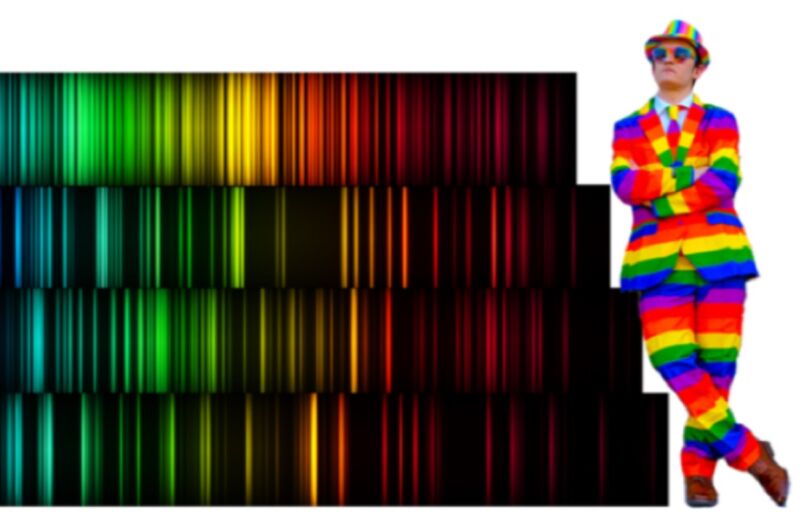
W Walker Smith e Alan Parker
Estamos todos familiarizados com os elementos da tabela periódica, mas você já se perguntou qual elemento hidrogênio ou zinco, por exemplo, pode voz Gosta? W. Walker Smith, agora um estudante de pós-graduação na Universidade de Indiana, combinou suas paixões gêmeas em química e música para criar o que ele chama de uma nova ferramenta audiovisual para comunicar conceitos de espectroscopia química.
Smith forneceu seus dados sonicação O projeto – que essencialmente converte os espectros visíveis dos elementos da tabela periódica em som – está na reunião da American Chemical Society esta semana em Indianápolis, Indiana. Smith até mostrou clipes de som de alguns dos elementos, juntamente com “estruturas” incorporando partículas maiores, durante seu show “Sound of Molecules”.
Como estudante universitário, “eu [earned] Dupla graduação em Composição Musical e Química, então sempre busquei uma forma de transformar minha pesquisa em química em música”, Smith disse durante uma coletiva de imprensa. “No final, me deparei com os espectros visuais dos elementos e fiquei maravilhado com o quão bonitos e diferentes todos eles pareciam. Achei que seria muito legal transformar esses espectros visuais, essas belas imagens, em som.”
Como são os itens?
A sonicação de dados não é um conceito novo. Por exemplo, em 2018, os cientistas alteraram uma imagem da NASA do rover Mars Opportunity em 5000y Nascer do sol em Marte na música. o dados de física de partículas Usado para descobrir o bóson de Higgs, os ecos de um buraco negro devorando uma estrela e as leituras do magnetômetro da missão Voyager também foram transformadas em música. Vários anos atrás, A.J.[[” embedded=”” url=”” link=”” data-uri=”d71e3e53769b46aa75512f689b034f33″>project called LHCSound built a library of the “sounds” of a top quark jet and the Higgs boson, among others. The project hoped to develop sonification as a technique for analyzing the data from particle collisions so that physicists could “detect” subatomic particles by ear.
Markus Buehler’s MIT lab famously mapped the molecular structure of proteins in spider silk threads onto musical theory to produce the “sound” of silk in hopes of establishing a radical new way to create designer proteins. The hierarchical elements of music composition (pitch, range, dynamics, tempo) are analogous to the hierarchical elements of protein structure. The lab even devised a way for humans to “enter” a 3D spider web and explore its structure both visually and aurally via a virtual reality setup. The ultimate aim is to learn to create similar synthetic spiderwebs and other structures that mimic the spider’s process.
Several years later, Buehler’s lab came up with an even more advanced system of making music out of a protein structure by computing the unique fingerprints of all the different secondary structures of proteins to make them audible via transposition—and then converting it back to create novel proteins never before seen in nature. The team also developed a free Android app called the Amino Acid Synthesizer so users could create their own protein “compositions” from the sounds of amino acids.
So Smith is in good company with his interactive periodic table project. All the elements release distinct wavelengths of light, depending on their electron energy levels, when stimulated by electricity or heat, and those chemical “fingerprints” make up the visible spectra at the heart of chemical spectroscopy. Smith translated those different frequencies of light into different pitches or musical notes using an instrument called the Light Soundinator 3000, scaling down those frequencies to be within the range of human hearing. He professed amazement at the sheer variety of sounds.
“Red light has the lowest frequency in the visible range, so it sounds like a lower musical pitch than violet,” said Smith, demonstrating on a toy color-coded xylophone. “If we move from red all the way up to violet, the frequency of the light keeps getting higher, and so does the frequency of the sound. Violet is almost double the frequency of red light, so it actually sounds close to a musical octave.” And while simpler spectra like hydrogen and helium, which only have a few lines in their spectra, sound like “vaguely musical” chords, elements with more complex spectra consisting of thousands of lines are dense and noisy, often sounding like “a cheesy horror movie effect,” according to Smith.
His favorites: helium and zinc. “If you listen to the frequencies [of helium] Um por um, em vez de todos de uma vez, disse Smith, você pode obter um padrão de escala interessante que usei para compor várias composições, incluindo “Helium Dance Party”. Quanto ao zinco, a primeira linha de grade de metais de transição soa muito complexa e densa. Mas Zinc, por qualquer motivo, apesar de sua infinidade de frequências, soa como um cantor angelical cantando vibrato. “
Smith está atualmente colaborando com o Wonder Lab Museum em Bloomington, Indiana, para desenvolver uma exposição de museu que permite aos visitantes interagir com a tabela periódica, ouvir lamentações e criar suas próprias composições musicais a partir dos vários sons. A principal coisa que eu quero [convey] é que a ciência e as artes não são, afinal, tão diferentes. “Combiná-los pode levar a novas questões de pesquisa, mas também a novas maneiras de se comunicar e alcançar públicos maiores.”

“Especialista em comida. Nerd de álcool. Leitor extremo. Empreendedor. Fanático devoto de mídia social. Especialista em cerveja ávido. Introvertido. Pensador freelance.”
